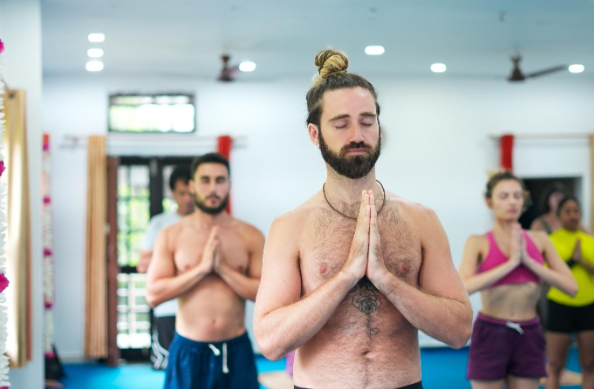Are you ready to take the next step in your yoga journey but unsure whether to begin with an RYT 200, advance to an RYT 300, or complete the full RYT 500 certification? With so many yoga teacher training programs available, choosing the right level can feel overwhelming — especially if you’re new to Yoga Alliance certification pathways. In this blog, we’ll break down the differences between RYT 200, RYT 300, and RYT 500, helping you understand the structure, prerequisites, benefits, and career potential of each. Whether you’re starting your first teacher training or looking to deepen your credentials, this guide will help you make an informed decision aligned with your goals and experience level.
What Is Yoga Teacher Training? A Beginner’s Guide
Yoga Teacher Training (YTT) is a comprehensive program designed to deepen your yoga practice and equip you with the skills to become a certified yoga instructor. Whether you aim to teach or simply want to explore yoga more profoundly, a YTT offers a structured path for both personal and professional growth.
A 200-hour Yoga Teacher Training Course, the most popular starting point, covers key areas like yoga philosophy, anatomy, postures, alignment, meditation, pranayama, and teaching methodology. Recognized by Yoga Alliance, this training is not just about certification—it’s a life-changing journey of self-discovery.
Who is it for? YTT is open to all levels—whether you’re a beginner or advanced practitioner. You don’t need to plan on teaching; many students join to deepen their practice, gain clarity, and embrace a more conscious lifestyle.
How to Choose Between RYT 200, RYT 300, and RYT 500 Yoga Teacher Training Certifications
In this guide, we’ll break down what RYT certifications mean, explore the key differences between them, and help you decide which yoga teacher training level is right for you.
What Does RYT Mean?
RYT stands for Registered Yoga Teacher, a credential recognized by Yoga Alliance, the most widely accepted yoga certification body globally. Being a Yoga Alliance-certified teacher means that you’ve completed training at a Registered Yoga School (RYS) and met the standards in areas like asana, anatomy, philosophy, and teaching methodology.
Yoga Alliance offers different levels of certification based on the number of training hours completed and teaching experience. These include:
- RYT 200 – the foundational certification
- RYT 300 – advanced-level training, building on the RYT 200
- RYT 500 – comprehensive training that includes both 200 and 300 hours
What Is an RYT 200 Certification?
The RYT 200 is the entry-level certification that serves as the first step for anyone aspiring to become a yoga teacher. It includes 200 hours of training and is designed to provide you with a strong foundation in yoga philosophy, anatomy, postures (asanas), alignment, pranayama (breathwork), meditation, and basic teaching techniques.
Who Should Choose RYT 200?
- Beginners or intermediate practitioners
- Anyone interested in teaching yoga professionally
- Those who want to deepen their personal practice and understanding of yoga
- Students with no prior teaching experience
This course typically spans 3 to 4 weeks in a full-time residential format, or several months for part-time or weekend formats.
After completing an RYT 200 course, you become eligible to register as an RYT 200 with Yoga Alliance and begin teaching group or private classes.
What Is an RYT 300 Certification?
The RYT 300 is an advanced-level 300-hour Yoga Teacher Training designed for those who have already completed their RYT 200 certification. It adds another 300 hours of intensive learning, with more focus on advanced asana practice, in-depth anatomy, subtle body studies (chakras, nadis), yoga philosophy, therapeutic applications, sequencing, and teaching skills.
Who Should Choose RYT 300?
- Certified RYT 200 teachers looking to expand their knowledge
- Teachers aiming to specialize in a particular style (e.g., Yin, Restorative, Ashtanga)
- Yoga instructors who want to build confidence and go deeper into yogic studies
- Those working toward the full RYT 500 designation
It’s important to note that an RYT 300 course must be taken after RYT 200. Once both are complete and registered, you qualify for the RYT 500 certification.
What Is an RYT 500 Certification?
The RYT 500 designation is the highest level of certification offered by Yoga Alliance. It signifies that you have completed a total of 500 hours of training, combining your RYT 200 and RYT 300 programs at Registered Yoga Schools.
Some schools also offer integrated 500-hour yoga teacher training programs, which allow you to complete the full RYT 500 certification in a single, extended course. These typically last 8 to 10 weeks or more.
Who Should Choose RYT 500?
- Dedicated yoga practitioners seeking advanced-level mastery
- Yoga teachers aiming to work in wellness centers, yoga schools, or internationally
- Individuals who want to become mentors or trainers for future yoga teachers
- Anyone seeking personal growth and a deeper spiritual journey
RYT 500 certification not only boosts your credibility but also opens doors to more teaching opportunities, including lead teaching roles in YTT programs.
Key Differences: RYT 200 vs RYT 300 vs RYT 500
| Feature | RYT 200 | RYT 300 | RYT 500 |
|---|---|---|---|
| Level | Beginner | Advanced (post-200 hr) | Master (200 + 300 hr) |
| Duration | 200 hours | 300 hours | 500 hours (total) |
| Eligibility | Open to all levels | Requires RYT 200 | Requires RYT 200 + RYT 300 |
| Content Focus | Foundational knowledge | Deepening & specialization | Full mastery & teaching depth |
| Outcome | Start teaching yoga | Advance your teaching career | Lead teaching, advanced roles |
Which Yoga Teacher Training Level Is Right for You?
Choosing the right yoga teacher training certification depends on your current level, commitment, and long-term goals.
Choose RYT 200 if:
- You are new to yoga or want to become a certified yoga teacher
- You’re looking for a strong foundation in yoga practice and philosophy
- You want a globally recognized certification to start teaching yoga
Choose RYT 300 if:
- You have completed an RYT 200 and want to deepen your practice
- You’re looking to specialize or refine your teaching skills
- You want to work toward the RYT 500 designation
Choose RYT 500 if:
- You are committed to a long-term career in yoga
- You want to take on leadership, mentorship, or training roles
- You’re seeking personal mastery and spiritual growth through yoga
Where to Do Your Yoga Teacher Training?
While there are yoga teacher training programs worldwide, Rishikesh, India, remains one of the most authentic and spiritual destinations to learn yoga. Known as the birthplace of yoga, Rishikesh offers a deeply immersive environment with experienced teachers, traditional ashrams, and serene surroundings ideal for yogic studies.
When selecting a program, ensure the school is a Registered Yoga School (RYS) with Yoga Alliance and check reviews, curriculum, teacher credentials, and student testimonials.
Final Thoughts:
Deciding between RYT 200, RYT 300, or RYT 500 yoga teacher training depends on where you are in your practice and where you want to go. If you’re just beginning, the RYT 200 offers the foundational knowledge and certification needed to start teaching. The RYT 300 is ideal for deepening your expertise, while the RYT 500 combines both and reflects a high level of dedication and mastery in the yogic path.
Whichever certification you choose, ensure it’s from a Yoga Alliance-registered school, taught by experienced instructors, and aligned with your personal and professional goals. The right YTT program will not only help you become a confident teacher but also support your transformation—on and off the mat.
Namaste 🙏

















